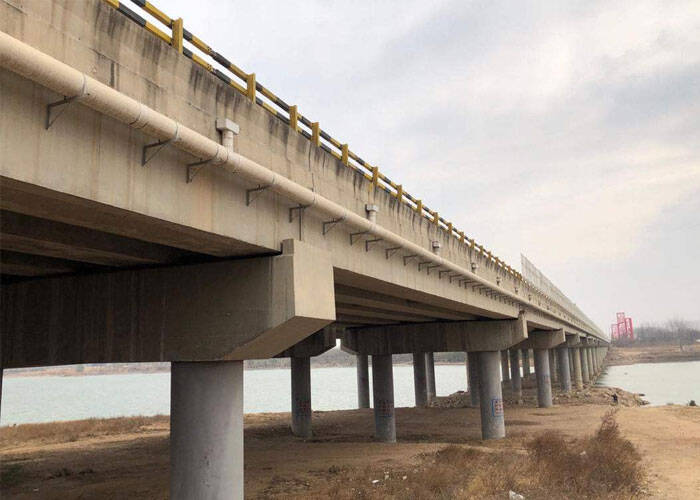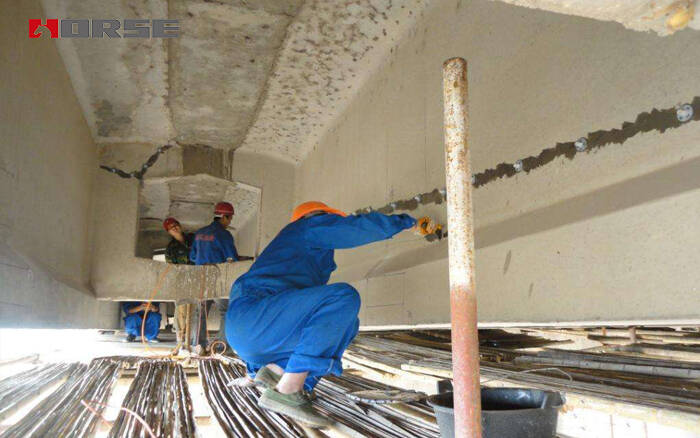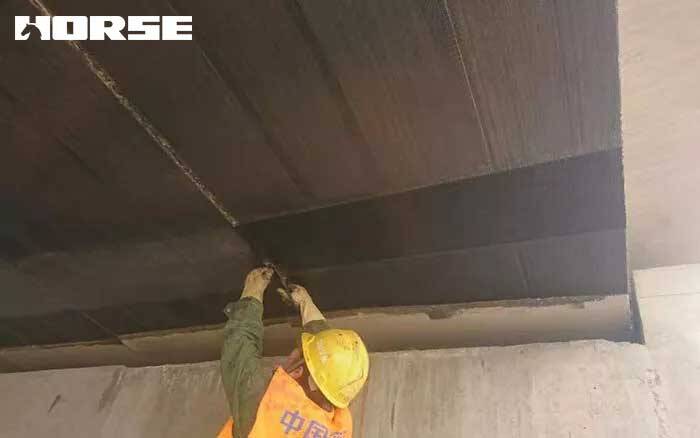Girder Strengthening and Repair
CFRP wrap
CFRP Wrapping Girder

Project Overview
Jiaoji Railway Ky140+742.3 Weihe Right Line Bridge, with a span of 9-31.7m reinforced concrete girder (low height), and a total length of 306m. There are transverse and longitudinal cracks ranging from 0.05 to 1.5 mm on the flange plates and webs of the T-girder body, and the cracks penetrate up and down and transversely. Cracks appeared in the girder L/4-L/3 and the mid-span position, the bottom plate basically penetrated and extended to the web and the root of the web. After inspection by the design unit and the Quality Supervision Station, it was confirmed that it can continue to be used under the condition of maintenance and reinforcement. Therefore, the 9-hole girder of the bridge was repaired and reinforced. Repair the crack length of 3000m, paste 6000m of CFRP wrap, and paste 200m of steel plate.
Reinforcement principles and measures
Longitudinal crack
(1) For longitudinal cracks and network cracks <0.1mm, use surface coating structural glue to seal the cracks. The net cracks are sealed with structural glue on the surface, and a layer of glass fiber wrap is covered. The length of the fiber wrap extends 1m outward from both ends of the mesh, and 1m on each side of the mesh.
(2) For the longitudinal cracks of 0.1mm~< cracks≤0.2mm, the "Bike method" vacuum grouting is used to fill and seal, and two layers of glass fiber wrap are pasted. Paste two layers of CFRP wrap horizontally on the horseshoe of the T girder and a layer of CFRP wrap longitudinally. The length of the fiber wrap extends 1m from both ends of the crack and 1m on both sides of the crack. The width of the fiber wrap of the horseshoe is to wrap to the inner corners of both sides of the horseshoe.
(3) For longitudinal or diagonal cracks> 0.2mm, the glass fiber wrap in the treatment measures in Article (2) shall be replaced by CFRP wrap, and the others are the same.
(4) After pasting the fiber wrap, apply structural glue to the outside to prevent aging, and try to match the color of the decoration after the fiber wrap with the original bridge color.
Transverse crack
(1) For non-span cracks. Taking into account the factors affecting the structural forces, after adopting the "Bike method" grouting, two layers of CFRP wrap are pasted on the bottom plate in the vertical direction of the crack. The length of the CFRP wrap is 2m along each side of the crack, the width is 0.5m, and the net spacing is about 0.8m, strip arrangement. The web is pasted with two layers of CFRP wrap along the 45-degree angle of the crack, extending to the root. The outer side of the fiber wrap is coated with a layer of structural glue to prevent aging, and is decorated to ensure that the decoration color is consistent with the color of the bridge concrete.
(2) Cracks in the middle of the span. After grouting by the "Bike method", part of the concrete was removed from the bottom plate, and a layer of 8mm thick 16Mn steel plate was pasted on the concrete surface to reinforce the vertical cracks by the "injection method". The length of the steel plate is retracted by 1m along the two sides of the crack to the point of cross-section change, the width is 0.5m, the clear spacing is 0.75~0.8m, and it is arranged in strips. After the steel plate is pasted, it is flush with the concrete. The web is pasted with two layers of CFRP wrap along the 45-degree angle of the crack, extending to the root. Apply structural glue on the surface of fiber wrap and steel plate and make decoration treatment to ensure that the decoration color is consistent with the color of bridge concrete.

Crack treatment process
Surface sealing crack treatment process
The cracks are sealed on the surface with HM-9 glue. The glue is composed of modified epoxy resin and curing agent, which mainly considers the durability of sealing cracks and the requirements of UV resistance. For cracks with seam width less than 0.1mm, apply micro-crack glue once, and then seal the seam with modified epoxy resin cement. The thickness of the cement is not less than 0.1mm and the width is not less than 25mm. The basic construction process is as follows: concrete surface treatment (clean and dry), micro-crack glue coating and infiltration, epoxy resin cement sealing, painting micro-crack glue, and checking the sealing quality.
Grouting construction technology
Check for cracks, crack surface treatment, paste injection seat, crack closure, and inject HM-120L grouting glue.
Clean the injection tool with acetone.
Curing and curing of injection materials: Generally, it can harden by itself after 10 to 24 hours. Knock off the injection seat after hardening.
Check the effect of grouting: use water seepage test, ultrasonic wave and core-drilling sampling for comparative testing.

Externally bonding unidirectional CFRP wrap
Concrete substrate treatment and cleaning. Coating the base resin. Repairing the incomplete adhesive surface. Pasting CFRP wrap. Conservation.
Paste steel plate construction process
Treatment of girder concrete base surface, drilling a steel plate positioning installation, adjusting the gap, arranging air pipes, injection holes, sealing around the steel plate, sealing glue, pouring structural glue, curing a hollow drum detection, acceptance-5mm mortar protective layer.
Conclusion
After the construction of the bridge was completed, the repaired cracks were inspected by ultrasonic, and core-drilling sampling was adopted for inspection. No cracks that were not filled up were found. The water was shut off on the top of the girder for 24 hours, and no water seepage was found in the girder body. At present, the on-site operating speed of the bridge has reached 100km/h after reinforcement. After a month of continuous observation, the girder fully meets the requirements for use.
This method is simple to construct, but requires the construction personnel to be careful and not to be sloppy, otherwise the cracks cannot be filled and the CFRP wrap cannot be adhered firmly. It is quite effective to use the above reinforcement methods for some bridge piers that have been used for a long time but have not yet reached the scrap time and are accidentally damaged or earthquake damaged during the construction process.
After the May 12 Wenchuan earthquake in 2008, after the piers and girders of the Guangyue branch railway bridge were damaged, this method was used to strengthen the cracks of the girders and piers in the emergency engineering, and achieved good results. effect. In the rescue and reinforcement of 6 bridges on the Guangyue branch line, a total of 5310kg of crack sealing pouring glue, 1700m of CFRP wrap reinforcement, and 40m of steel glue were completed.